Dolba hyloeus
DOLL-baM
hye-LEE-us
Pawpaw Sphinx
(Drury, 1773) Sphinx
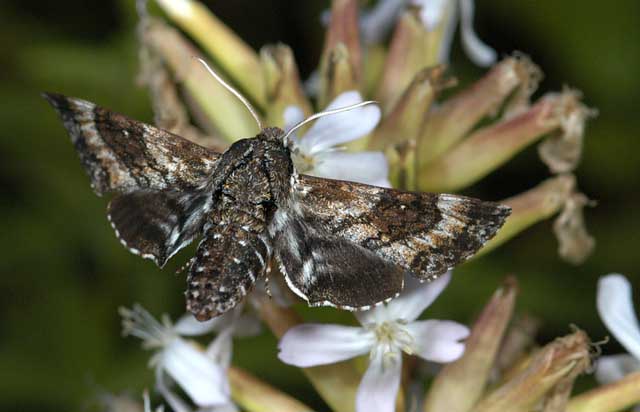
Dolba hyloeus, Flatbrookville, Sussex County, New Jersey,
July 2008, nectaring at bouncing bet, courtesy of
Jeff Swick.
This site has been created by Bill Oehlke.
Comments, suggestions and/or additional information are welcomed by Bill.
TAXONOMY:
Family: Sphingidae, Latreille, 1802
Subfamily: Sphinginae, Latreille, [1802]
Tribe: Sphingini, Latreille, 1802
Genus: Dolba Walker, 1856 ...........
Species: hyloeus (Drury, 1773)
|
DISTRIBUTION:
The Pawpaw Sphinx or Blackalder Sphinx,
Dolba hyloeus
(Wing span: 2 - 2 11/16 inches (5 - 6.8 cm)], flies from Maine south to Florida, west to Wisconsin, eastern Oklahoma,
and south to Texas. New York is the specimen type locality. The moth also flies in southern Ontario and southern Quebec, and might be in southern New Brunsswick.
In June, 2020, Derek Bridgehouse sends the following image, a new provincial record, from Nova Scotia.
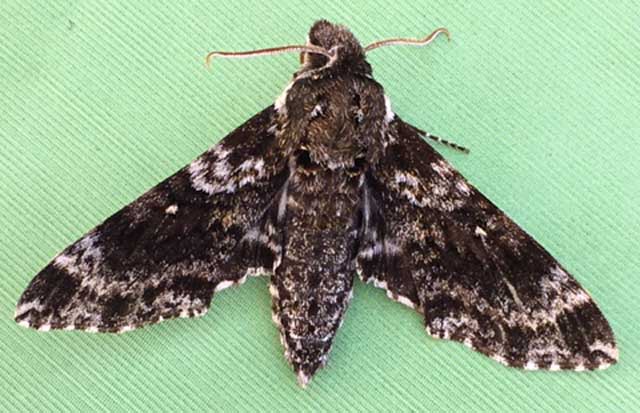
Dolba hyloeus, Nova Scotia, June, 2020, courtesy of Derek Bridgehouse,
a new provincial record for Nova Scotia.
Mike Van Buskirk has sent an image of a larva from central Texas (Kendall County), probably the western limit of its
southwestern range.
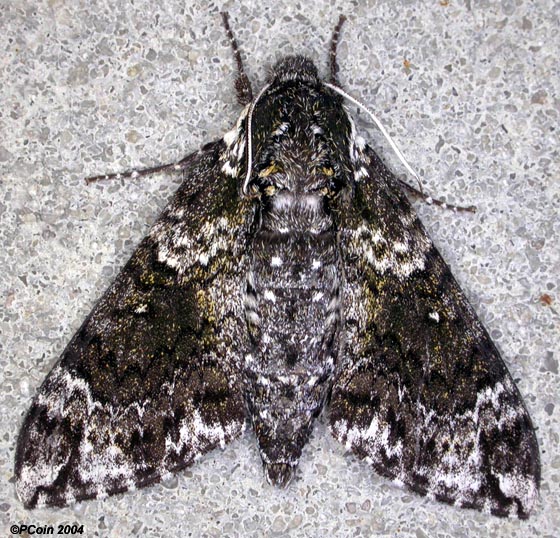
Dolba hyloeus
� Patrick Coin, used with permission,
Durham County, North Carolina, June 9, 2004
The upperside of the forewing is dark brown with a dusting of white scales. Some moths have patches of reddish or
yellowish brown on the wings.
Visit Dolba hyloeus
Austin, Texas, May 13, 2008, courtesy of Rick Gentry.
Visit Dolbahyloeus, Ogemaw County, Michigan, June 19, 2012, Cindy Mead
Visit Dolba hyloeus
nectaring at bouncing bet, Flatbrookville, Sussex County, New Jersey, July 2008, courtesy of Jeff Swick.
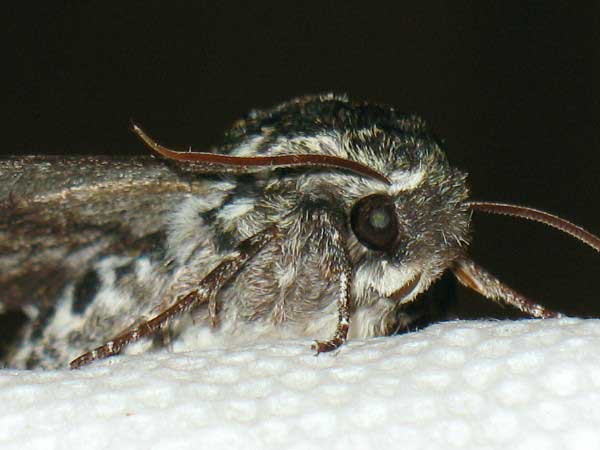
Dolba hyloeus July 2007, Sussex County, New Jersey, courtesy of Joe Garris.
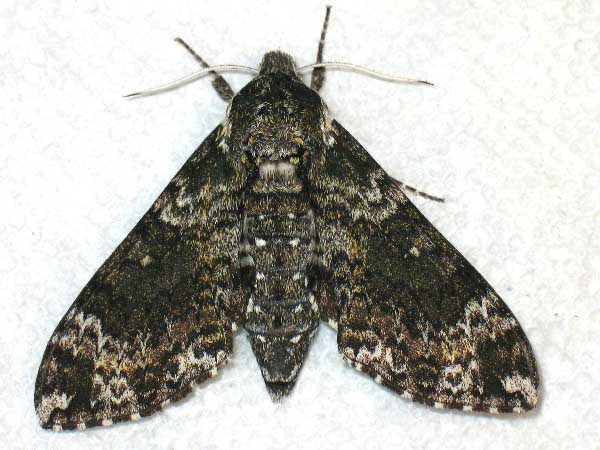
Dolba hyloeus July 2007, Sussex County, New Jersey, courtesy of Joe Garris.
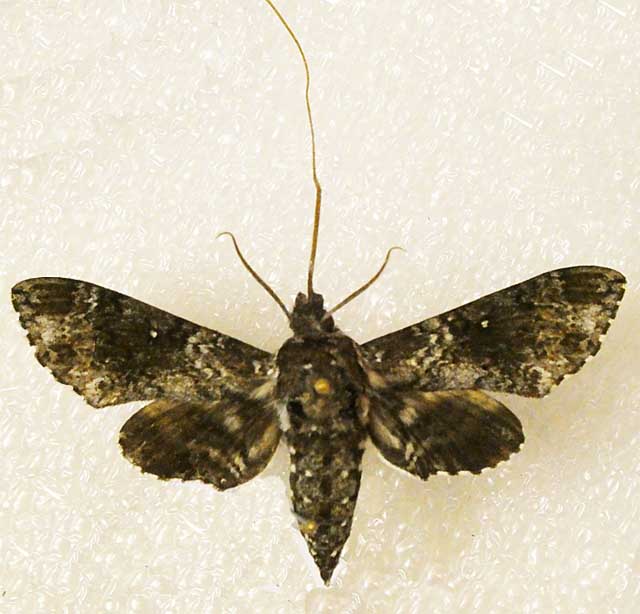
Dolba hyloeus, Florida, via Taylor Jones.
FLIGHT TIMES:
Dolba hyloeus adults fly as a single brood from June-September in northern
portions of its range and as two flights from March-September in Florida and Louisiana.
ECLOSION:
Pupae probably wiggle to surface from subterranean chambers just prior to eclosion.
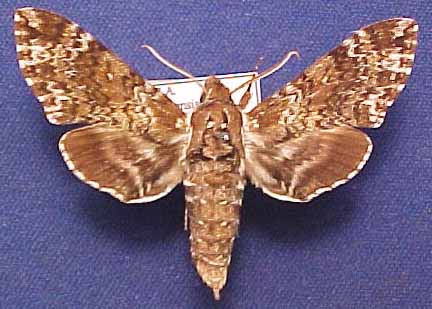
Dolba hyloeus by John Vriesi
SCENTING AND MATING:Females call in the males with a pheromone released from a gland at the tip of the
abdomen. Adults nectar from deep-throated flowers including bouncing bet (Saponaria officinalis),
Petunia, jasmine, and mimosa.
EGGS, LARVAE, PUPAE:
Larvae feed on pawpaw (Asimina triloba), littleleaf sweetfern
(Myrica aspleniifolia), possum haw (Ilex decidua), and inkberry (Ilex glabra) as well
as Tall Gallberry Holly (Ilex coriacea).
Louis Handfield reports larvae probably feed on Ilex verticellata in Quebec.
Many thanks to Jess Weldon from the Round Rock area in Williamson County, Texas, who captured a female Dolba hyloeus, obtained eggs and
also finds hatchlng larvae accept Ilex vomitoria, �Pride of Houston", and Jess is also going to try them on Calia secundiflora,
Texas Mountain Laurel.
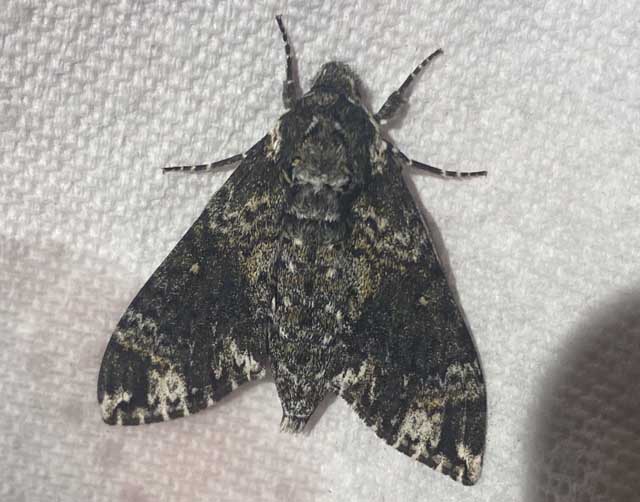
Dolba hyloeus female, Round Rock, Williamson County, Texas,
late July, 2021, courtesy of Jess Weldon.
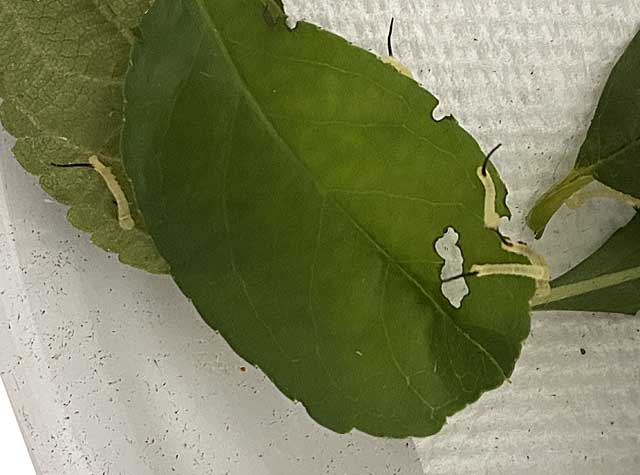
Dolba hyloeus hatchlings, Round Rock, Williamson County, Texas,
on Ilex vomitoria, August 11, 2021, courtesy of Jess Weldon.
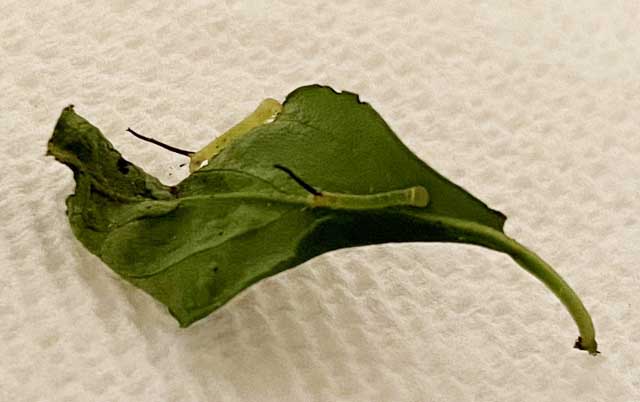
Dolba hyloeus hatchlings, Round Rock, Williamson County, Texas,
on Ilex vomitoria, August 11, 2021, courtesy of Jess Weldon.
Hatchling larvae are a pale yellow with a dark black anal horn, approximately 2/3 to 3/4 of the body length. I suspect when the larvae are not feeding
they rest on the central vein on the underside of the leaf, as per second immage above.
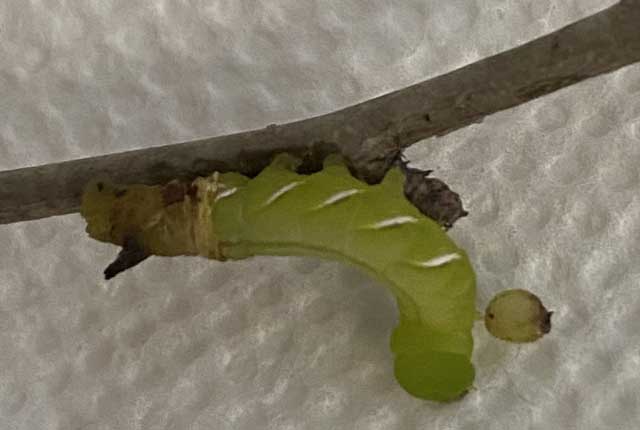
Dolba hyloeus moulting, probably from second to third instar, Round Rock, Williamson County, Texas,
on Ilex vomitoria, note discarded head capsule and incomplete skin shed, courtesy of Jess Weldon.
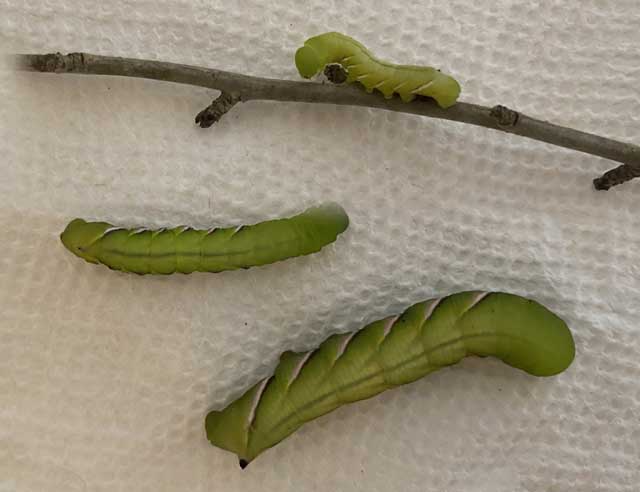
Dolba hyloeus, probably from third to final instar, Round Rock, Williamson County, Texas,
on Ilex vomitoria, note size difference with constant pattern, courtesy of Jess Weldon.
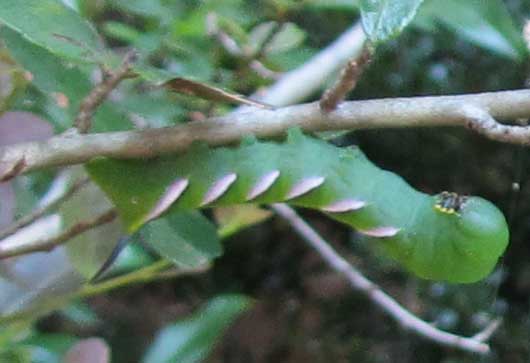
Dolba hyloeus on Yaupon, Wake County, North Carolina,
August 17, 2012, courtesy of Annie Runyon.
Annie Runyon sends the image of a Dolba hyloeus
caterpillar devouring the Yaupon (Ilex vomitoria) foliage in her yard in Wake County,
August 17, 2012.
Annie writes, "On August 17, 2012, I photographed (not very well, sorry) this caterpillar eating yaupon leaves in my yard in Wake County, NC.
(Yaupon is plant from yard on Ocracoke Island, Hyde County, NC. I am growing it here for tea.)
"Ed Corey suggests it is a Dolba hyloeus and so I ended up reading about them on your fine website. I noticed no one has reported them eating yaupon,
so I thought you might be interested. Unfortunately, all that remains of the cat today is black blood on leaves below where it rested overnight. But now that
I have seen one, I�ll look for more ... and in my pawpaws as well."
I reply: "Hi Annie,
"Ilex vomitoria is a close relative to many of the other Ilex species known as hosts, so it is not such a big surprise. Yes, it is
Dolba hyloeus, and I would like to post an image, credited to you, to a Wake County thumbnail checklist page I will create?"
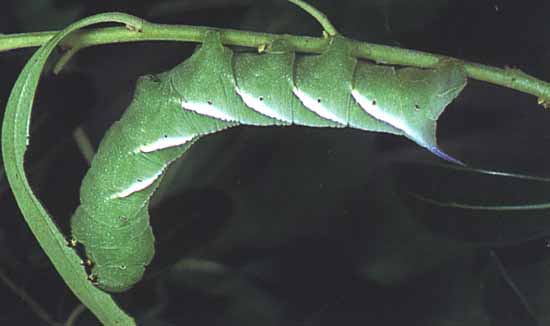
Dolba hyloeus larva courtesy of David Wagner.
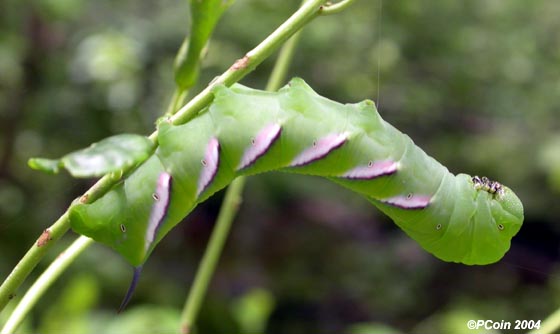
Dolba hyloeus
� Patrick Coin, used with permission,
Weymouth Woods, Moore County, North Carolina,
June 5, 2004,
Feeding on Tall Gallberry Holly--Ilex coriacea.

Dolba hyloeus, Louisiana, courtesy/copyright
Vernon Brou.
Visit Dolba hyloeus, green and brown forms, Groton,
Middlesex County, Massachusetts, courtesy of Tom Murray.
Visit Dolba hyloeus, green form,
Kendall County, Texas, May 20, 2010, courtesy of Mike Van Buskirk.
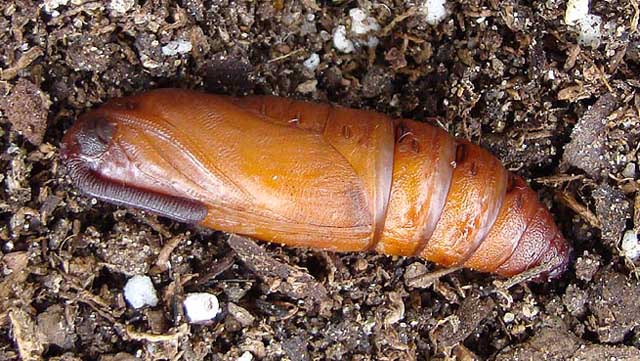
Dolba hyloeus pupa, Glenn Heights, Dallas County, Texas,
August 23, 2007, courtesy of Dale Clark.
Return to U. S.A. Table
Return to Sphingidae Index
Return to Sphingini Tribe
Use your browser "Back" button to return to the previous page.
This page is brought to you by Bill Oehlke and the
WLSS. Pages are on space rented from Bizland. If you would like
to become a "Patron of the Sphingidae Site", contact Bill.
Please send sightings/images to Bill. I will do my best to respond to requests for identification help.
Enjoy one of nature's wonderments: Live Saturniidae (Giant Silkmoth) cocoons.
















